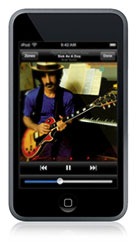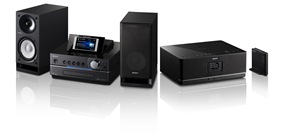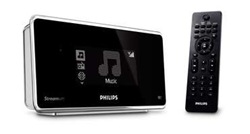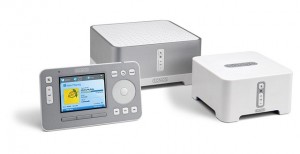






The Sooloos system consists of three different components. The Store which is the actual disk, the Source which streams the music to up to 32 zones and the Control which is a 17” touch screen with a built in CD drive [“Music isn’t all zones, terabytes, and signal-to-noise ratios”, they say]. Additional controls in the form of a 7” remote or a 7” satellite are available.
The Sooloos is the second system I have come across that uses mirroring on its datastore. Considering that hopefully more and more music will be downloadable in lossless audio formats the backup implications become more challenging; in case of a disk crash, how do you get your music back? A CD is straight forward. Buy it again and rip it once more. With music from, let’s say the B&W Music Club, you are in a jam. You cannot simply redownload music from previous months. A backup is actually a very good thing to consider in these days of digital distribution.
An interesting and rather important point with the Sooloos system is that CDs are ripped as one large file rather than individual tracks. This ensures that when songs or, perhaps more importantly, musical movements are played in order, they are played with exactly the gaps they were supposed to. If you play individual tracks they are seeked at runtime, so the obvious shortcoming of this method has been taken care of.
 Those who own both a Sonos system and an iPhone or ipod Touch now have the option of controlling their Sonos system from not only the indeed very jazzy Sonos controller but from their phone as well.
Those who own both a Sonos system and an iPhone or ipod Touch now have the option of controlling their Sonos system from not only the indeed very jazzy Sonos controller but from their phone as well. Pioneer have outdone themselves mating purist zen like styling and an outstanding feature set in this new
Pioneer have outdone themselves mating purist zen like styling and an outstanding feature set in this new  This is a complete system with zone system serving up to 5 rooms, ripping from CD and lossless streaming [
This is a complete system with zone system serving up to 5 rooms, ripping from CD and lossless streaming [ The Philips Streamium system has been extended with an internet radio, not entirely unlike the SLA5500 mentioned in the
The Philips Streamium system has been extended with an internet radio, not entirely unlike the SLA5500 mentioned in the  A household name in hi-fi circles and it can hardly surprise anyone that Arcam too have a media streamer. It supports lossless encoding, even if it is unclear which formats. The MS250 contains a 400GB harddisk and ripping capabilities. Add to that streaming to 4 simultaneous zones and that in itself should be a nicely equipped addition to most audio systems. What makes this apparatus truly stand out is not its digital connections but its analogue input. It can actually record or stream from an analogue source – nifty! Really; consider streaming from your turntable to 4 different rooms… nifty!
A household name in hi-fi circles and it can hardly surprise anyone that Arcam too have a media streamer. It supports lossless encoding, even if it is unclear which formats. The MS250 contains a 400GB harddisk and ripping capabilities. Add to that streaming to 4 simultaneous zones and that in itself should be a nicely equipped addition to most audio systems. What makes this apparatus truly stand out is not its digital connections but its analogue input. It can actually record or stream from an analogue source – nifty! Really; consider streaming from your turntable to 4 different rooms… nifty!
 Tivoli Audio are known for some of the coolest table top radios on the market in general and for Henry Kloss’ design in particular. They too have jumped on the wagon and done a streaming piece of art with their new NetWorks.
Tivoli Audio are known for some of the coolest table top radios on the market in general and for Henry Kloss’ design in particular. They too have jumped on the wagon and done a streaming piece of art with their new NetWorks.
 With their MusicPal internet radio, Freecom shows a fairly classy looking albeit, barebone device. Like the
With their MusicPal internet radio, Freecom shows a fairly classy looking albeit, barebone device. Like the